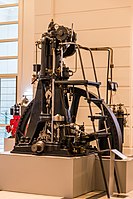
Photo from wikipedia
Abstract An inherent serious problem was noticed when the two-region Porous-Inert-Medium (PIM) burners were started-up at low-powers. The ignition near their downstream surface, failed to commence a correct combustion process.… Click to show full abstract
Abstract An inherent serious problem was noticed when the two-region Porous-Inert-Medium (PIM) burners were started-up at low-powers. The ignition near their downstream surface, failed to commence a correct combustion process. Depending on a limiting excess-air-ratio (λ), two distinct combustion patterns were detected. A noisy-explosive flame-plume was remarked for values below this limit, while a suspended free-flame on the downstream surface was observed for values above this limit. The combustion process was self-extinguished in both patterns. A systematic study was performed to explore this phenomenon. The real-time temperature variation was measured along a two-region PIM burner of wire-mesh and SiC-foam materials of different configurations as supercritical regions. It was fueled with Liquefied-Petroleum-Gas (LPG) and examined at several elevated low-powers between 0.576 and 2.535 kW. All the applied powers were checked at the same λ values between 0.73 and 1.58. An essential limiting power, associated with every PIM configuration, or higher at λ below the limiting value should be applied for an adequate and immediate startup. The limiting λ was found to depend only on the PIM material. Therefore, researchers and designers of PIM burners should identify these limiting power and λ values for their own PIM configurations before devoting them in real-appliances.
Journal Title: Energy
Year Published: 2020
Link to full text (if available)
Share on Social Media: Sign Up to like & get
recommendations!